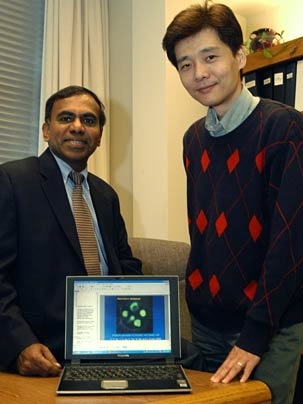Subra Suresh has spent the last two decades studying the mechanical properties of engineered materials from the atomic to the structural scale. So, until recently, the head of MIT's Department of Materials Science and Engineering never thought he'd be a player in the hunt for cures to malaria and pancreatic cancer.
It turns out, however, that Suresh's expertise in nanotechnology is quite applicable to biology and medicine. With colleagues in engineering, science and medicine at MIT, the National University of Singapore (NUS) and the universities of Heidelberg and Ulm in Germany, he has adapted state-of-the-art tools for the study of the mechanical properties of materials to the study of living cells.
Now, in the January 2005 issue of Acta Biomaterialia, the researchers report the most complete and quantitative characterization yet of how a healthy human blood cell changes its shape, or deforms, upon being invaded by the malaria-inducing parasite Plasmodium falciparum. In the same article, the researchers show how the deformation of human pancreatic cancer cells in response to certain naturally occurring biomolecules may affect the metastasis of that disease. Ultimately, the work could lead to better treatments for these and other diseases.
Suresh's coauthors are graduate student John P. Mills and research scientist Ming Dao of MIT's Department of Materials Science and Engineering, Professor Joachim Spatz and Alexandre Micoulet of the University of Heidelberg, Professor C. T. Lim of NUS, and Professor Thomas Seufferlein and Mark Beil of the University of Ulm.
Malaria and the cell
Healthy red blood cells regularly contort from circular disks to slender "bullets" to move through the tiniest blood vessels. Parasite-infected cells can lose their ability to do so because of reduced deformability and because they tend to stick more easily to one another and to blood vessel walls.
"It has been a great challenge to directly measure the cells' changing mechanical properties continuously as the parasite matures inside the cell," said Suresh, the Ford Professor of Engineering, who also holds appointments in MIT's Department of Mechanical Engineering and Biological Engineering Division.
In the Acta Biomaterialia paper, the researchers report doing just that. "We provide the first quantitative force versus displacement results on how the deformability of the red blood cell changes progressively in response to the full development of the P. falciparum parasite inside the cell," Suresh said.
"Such information at the molecular level is vital to gain insights into the pathogenesis of malaria, and potentially offers the opportunity to develop better drugs," Suresh added. Precise measurements of infected cells' response to mechanical forces could also help doctors understand how different strains of the parasite influence the functioning of organs such as the spleen.
Optical tweezers
Key to the work is a known tool: optical tweezers. With this tool, silica spheres or beads are attached to opposite sides of a red blood cell, and a laser beam is aimed at one bead. Under the right conditions, the laser "traps" the bead, so that the trapped bead can be pulled, stretching or deforming the cell.
While others have also used optical tweezers to study the deformation of cells, the forces they've been able to apply are far less than those needed to induce the deformation that cells would experience in the body. The forces obtained by the MIT-led researchers are several times larger, and their technique offers considerably greater flexibility to mechanically manipulate cells than other methods. "This really gives a level of strain for the red blood cell that is similar to what that cell experiences as it moves through tiny blood vessels," said Suresh.
"We then extract the properties of a healthy red blood cell and a parasite-invaded cell from a combination of experiments and 3D computer modeling at the full-cell and molecular levels," he continued. His team, along with NUS microbiologist Kevin Tan and NUS graduate student Qie Lan, is also collaborating with the Institut Pasteur in Paris to explore how specific proteins transported from the surface of parasite to the cell contribute to changes in cell mechanical properties and stickiness.
Malaria kills some two to three million people every year. "I'm hopeful that this work will provide a deeper scientific understanding of how malaria affects cells by bringing cutting-edge engineering methodology to study medical problems," Suresh said.
The work is supported by NUS, the Alexander von Humboldt Foundation in Germany, the German Science Foundation, the Interdisciplinary Center for Clinical Research at the University of Ulm, and the Association for International Cancer Research.
A version of this article appeared in MIT Tech Talk on December 15, 2004 (download PDF).







